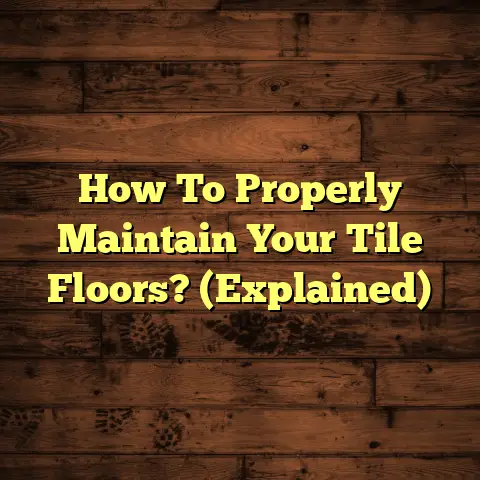Is Laminate Finished Wood? (7 Myths Busted!)
“Wood is an essential part of our lives. It is a material that has been used for centuries, and its beauty and functionality continue to inspire.” – Unknown
As a flooring contractor with years of experience, I’ve seen my fair share of flooring choices, and laminate flooring always seems to spark a debate. Is it really wood? Is it just a cheap imitation?These are questions I hear all the time.
Laminate flooring has exploded in popularity over the last decade. It’s affordable, relatively easy to install, and comes in a dizzying array of styles. But with this popularity comes confusion. People often mistake it for real wood, or have misconceptions about its durability and environmental impact.
That’s why I’m here to set the record straight.
In this article, we’re diving deep into the world of laminate flooring. We’ll explore what it actually is, how it compares to real wood, and bust seven common myths that might be holding you back from considering it for your next project. So, grab a cup of coffee, and let’s get started!
Myth 1: Laminate is Real Wood
Okay, let’s tackle the biggest misconception right off the bat: Laminate is not real wood. I know, I know, some laminate floors look incredibly realistic these days. But trust me, it’s all smoke and mirrors (or rather, high-resolution photography and clever manufacturing).
So, what is laminate flooring made of?
Well, it’s a multi-layered synthetic flooring product. The typical construction looks something like this:
-
Wear Layer: This is the top layer, a transparent coating that protects the floor from scratches, stains, and fading. It’s the first line of defense against daily wear and tear.
-
Decorative Layer: This is where the magic happens. It’s a high-resolution photographic image that mimics the look of wood, stone, tile, or just about anything else you can imagine.
-
Core Layer: This is the heart of the laminate plank. It’s usually made of high-density fiberboard (HDF) or medium-density fiberboard (MDF). This layer provides stability and impact resistance.
-
Backing Layer: This bottom layer provides a moisture barrier and helps to balance the plank, preventing warping.
Think of it like a really fancy, durable photograph glued to a strong board.
Solid hardwood flooring, on the other hand, is made from a single piece of wood, milled from a tree. It’s a natural product through and through. You can see the difference in the grain, the texture, and even the way it feels underfoot.
The Visual Deception: Laminate flooring has come a long way in terms of mimicking real wood. Manufacturers use advanced printing techniques and embossing to create realistic textures and grain patterns. Some even incorporate beveled edges to simulate the look of individual wood planks.
But no matter how good it looks, it’s still not the real deal. You won’t find the unique variations and imperfections that are inherent in natural wood. Each plank is essentially a copy of the same image, repeated across the floor.
So, while laminate can resemble real wood beautifully, it’s crucial to understand that it’s a synthetic material designed to look like wood.
Myth 2: Laminate is Just as Durable as Hardwood
Durability is a huge factor when choosing flooring. We all want something that can withstand the test of time (and kids, pets, and clumsy relatives!). So, how does laminate stack up against hardwood in terms of durability?
The truth is, it’s a bit of a mixed bag.
Laminate flooring is known for its impressive scratch and stain resistance, thanks to that tough wear layer I mentioned earlier. It can handle everyday spills and messes with ease, making it a great choice for busy households.
Hardwood, on the other hand, is more susceptible to scratches and dents. While it can be refinished to restore its original beauty, it requires more care and maintenance to keep it looking its best.
Water Resistance: This is where laminate really shines. Most laminate floors are highly water-resistant, making them suitable for kitchens, bathrooms, and even basements (though you still need to be careful about standing water).
Hardwood, on the other hand, is very sensitive to moisture. It can warp, swell, and even rot if exposed to water for prolonged periods.
Longevity: Hardwood flooring, when properly cared for, can last for generations. It’s a timeless investment that adds value to your home.
Laminate flooring, while durable, typically has a shorter lifespan. Depending on the quality and the amount of traffic it endures, you can expect it to last anywhere from 10 to 25 years.
The Numbers Game: According to a study by the North American Laminate Flooring Association (NALFA), high-quality laminate flooring can withstand up to 1,200 pounds per square inch (PSI) of pressure. In comparison, some hardwoods may only withstand around 800 PSI.
However, it’s important to note that these numbers can vary widely depending on the specific product and the type of wood.
Here’s a quick comparison table:
| Feature | Laminate | Hardwood |
|---|---|---|
| Scratch Resistance | Excellent | Good (requires more care) |
| Water Resistance | Very Good | Poor |
| Longevity | 10-25 years | Generations |
| Maintenance | Easy | Moderate |
| Refinishing | Not possible | Possible |
So, while laminate is durable in its own right, it’s not quite as durable as a well-maintained hardwood floor. However, for many homeowners, its water resistance and ease of maintenance make it a worthwhile trade-off.
Myth 3: Laminate Cannot Be Refinished
This is another big one, and it’s a definite “no.” You simply cannot refinish laminate flooring.
Why not?
Well, remember that decorative layer I talked about? That’s just a thin photographic image. If you try to sand it down like you would with hardwood, you’ll end up destroying the image and exposing the core layer, which is not meant to be seen.
Hardwood flooring, on the other hand, can be sanded down and refinished multiple times, allowing you to change the color, repair scratches, and restore its original beauty. This is a major advantage of hardwood, as it allows you to update the look of your floor without having to replace it entirely.
Alternative Options: So, what do you do if your laminate floor starts to look worn or outdated? Unfortunately, your only real option is to replace it.
However, there are a few things you can do to extend the life of your laminate floor and keep it looking its best:
-
Regular Cleaning: Sweep or vacuum regularly to remove dirt and debris that can scratch the surface.
-
Protective Mats: Place mats at entrances and in high-traffic areas to prevent dirt and moisture from being tracked onto the floor.
-
Furniture Pads: Use furniture pads under the legs of chairs and tables to prevent scratches and dents.
-
Professional Cleaning: Consider hiring a professional cleaning service to deep clean your laminate floor every few years.
While these tips won’t make your laminate floor last forever, they can help to keep it looking its best for as long as possible.
Myth 4: Laminate is Environmentally Unfriendly
In today’s world, environmental concerns are more important than ever. So, it’s natural to wonder about the environmental impact of your flooring choices. Is laminate an eco-friendly option?
The answer is… it depends.
Laminate flooring has gotten a bad rap in the past, due to concerns about formaldehyde emissions and the use of virgin wood fibers. However, the industry has made significant strides in recent years to address these concerns.
Sustainable Materials: Many laminate manufacturers now use recycled wood fibers in their core layers. This helps to reduce the demand for virgin wood and minimizes waste.
Low Emissions: Look for laminate flooring that is CARB (California Air Resources Board) compliant or FloorScore certified. These certifications indicate that the product has been tested and meets strict standards for low emissions of volatile organic compounds (VOCs), including formaldehyde.
Manufacturing Processes: Some manufacturers are also implementing more sustainable manufacturing processes, such as using water-based adhesives and reducing energy consumption.
The Counterargument: It’s important to acknowledge that laminate flooring is still a synthetic product, and its production does require energy and resources. Additionally, when it reaches the end of its lifespan, it’s not biodegradable and will likely end up in a landfill.
Hardwood flooring, on the other hand, is a natural product that can be sustainably harvested and is biodegradable. However, the environmental impact of hardwood flooring depends on the source of the wood. Look for wood that is certified by the Forest Stewardship Council (FSC) to ensure that it comes from responsibly managed forests.
Here’s a table summarizing the environmental considerations:
| Factor | Laminate | Hardwood |
|---|---|---|
| Materials | Recycled wood fibers, synthetic materials | Natural wood |
| Emissions | Low VOC options available | Naturally low VOC |
| Manufacturing | Energy-intensive | Less energy-intensive (depending on source) |
| End-of-Life | Landfill | Biodegradable |
| Certifications | CARB, FloorScore | FSC |
Ultimately, the environmental impact of your flooring choice depends on a variety of factors. By choosing laminate flooring made with recycled materials and low emissions, you can minimize its environmental footprint.
Myth 5: Laminate Floats on the Subfloor
Let’s talk about installation. You might have heard that laminate flooring “floats” on the subfloor. What does that even mean? And is it true?
Yes, it’s true! Most laminate flooring is installed as a “floating floor.” This means that the planks are not glued or nailed directly to the subfloor. Instead, they are connected to each other using a tongue-and-groove system, creating a single, continuous surface that rests on top of the subfloor.
Benefits of Floating Installation:
-
Ease of Installation: Floating floors are relatively easy to install, making them a popular choice for DIYers.
-
Versatility: They can be installed over a variety of subfloors, including concrete, plywood, and even existing flooring (as long as it’s level and in good condition).
-
Comfort: Floating floors can provide a more comfortable walking surface, as they have some give and flexibility.
-
Cost-Effective: Floating floors can be less expensive to install than traditional flooring methods, as they require less labor and materials.
Underlayment is Key: While the laminate floor itself “floats,” it’s crucial to install a proper underlayment between the laminate and the subfloor. Underlayment provides a cushion, reduces noise, and helps to protect the laminate from moisture.
Moisture Barriers: In areas with high moisture levels, such as basements, it’s also important to install a moisture barrier underneath the underlayment. This will prevent moisture from seeping up from the subfloor and damaging the laminate.
So, while laminate flooring does “float” on the subfloor, it’s not just sitting there willy-nilly. It’s a carefully engineered system that relies on proper installation and the use of underlayment and moisture barriers to ensure its long-term performance.
Myth 6: Laminate is Only Available in Wood-Look Finishes
Okay, let’s bust another common misconception. While laminate flooring is often associated with wood-look finishes, that’s not the only option available. In fact, laminate flooring comes in a huge variety of designs and styles.
Stone and Tile Looks: Thanks to advances in printing technology, laminate flooring can now mimic the look of stone, tile, and even concrete with incredible realism. You can find laminate that looks like everything from classic marble to rustic slate.
Abstract and Decorative Patterns: If you’re feeling adventurous, you can even find laminate flooring with abstract and decorative patterns. This is a great way to add a unique and personal touch to your home.
The Market Speaks: According to a recent survey by Statista, while wood-look laminate flooring remains the most popular choice, stone and tile looks are gaining traction, particularly in kitchens and bathrooms.
Consumer Preferences: The increasing popularity of non-wood looks is driven by a desire for more variety and the ability to create unique and personalized spaces. Homeowners are also drawn to the durability and water resistance of laminate, making it a practical choice for high-traffic areas.
So, don’t let the name “laminate flooring” fool you. It’s a versatile material that can be used to create a wide range of looks, from traditional to modern.
Myth 7: Laminate is Cheap and Low Quality
Finally, let’s address the misconception that laminate flooring is synonymous with low quality. While it’s true that there are budget-friendly laminate options available, that doesn’t mean that all laminate is created equal.
Quality Varies: Like any product, laminate flooring comes in a range of qualities. The quality of the laminate depends on factors such as the thickness of the wear layer, the density of the core, and the quality of the printing.
Budget-Friendly Options: Entry-level laminate flooring can be a great choice for those on a tight budget. However, it’s important to be aware that these options may not be as durable or long-lasting as higher-end laminates.
High-End Selections: High-end laminate flooring can be surprisingly expensive, but it offers superior durability, realism, and style. These laminates often feature thicker wear layers, more realistic textures, and advanced moisture resistance.
Advancements in Technology: Laminate technology has come a long way in recent years. Manufacturers are constantly developing new and improved laminates that offer better performance and aesthetics.
Price vs. Value: While laminate flooring may not be as luxurious as hardwood, it offers excellent value for the price. It’s a durable, easy-to-maintain, and stylish flooring option that can be a great choice for many homeowners.
My Experience: In my experience as a flooring contractor, I’ve installed both budget-friendly and high-end laminate flooring. I can honestly say that the higher-end laminates are well worth the investment. They look and feel much more like real wood, and they hold up much better to wear and tear.
So, don’t let the price tag fool you. Laminate flooring can be a high-quality and stylish option that adds value to your home.
Conclusion
So, there you have it! We’ve debunked seven common myths about laminate flooring, and hopefully, you now have a better understanding of what it is and what it isn’t.
Laminate is not real wood. It can be durable, but not quite as durable as hardwood. You can’t refinish it, but you can find eco-friendly options. It floats on the subfloor, and it comes in a wide variety of styles beyond wood looks. And, finally, it’s not always cheap and low quality.
Understanding these key points is essential for making informed choices when it comes to flooring. Laminate flooring can be a great option for many homes, offering a balance of style, durability, and affordability.
Ultimately, the best flooring choice for you will depend on your individual needs, budget, and lifestyle. Do your research, compare your options, and choose the flooring that best suits your needs.
And remember, a well-informed decision is always the best decision!





